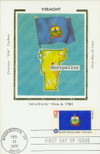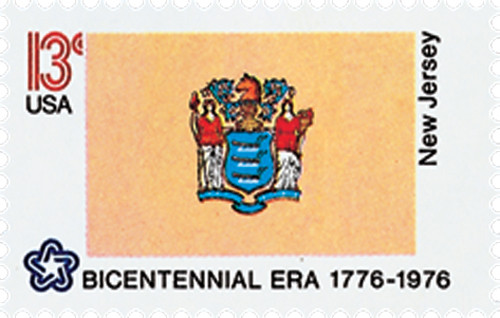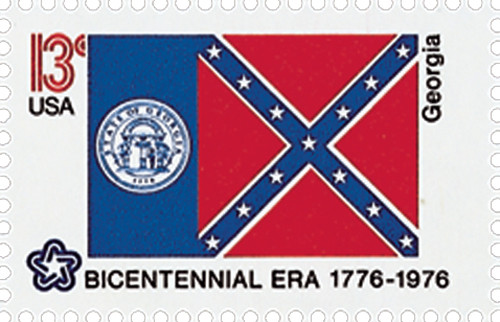
# 1646 - 1976 13c State Flags: Vermont
U.S. 1646
1976 Vermont Flag
State Flags
American Bicentennial Series
• First time a sheet 50 had all different stamp designs
• Part of the American Bicentennial Series
Stamp Category: Commemorative
Series: American Bicentennial Series
Value: 13¢ First-class postage rate
First Day of Issue: February 23, 1976
First Day City(s): Washington, DC
Quantity Issued: 8,720,100 (panes of 50)
Printed by: Bureau of Engraving and Printing
Printing Method: Photogravure
Format: Sheet of 50
Perforations: 11
Why the stamp was issued:
The United States Postal Service celebrated the American Bicentennial with a full pane of the Union’s fifty state flags.
About the stamp design:
Vermont’s state flag pictures a tall pine tree, a cow, and sheaves of wheat with the Green Mountains in the distance. The name "Vermont" and the state motto "Freedom and Unity" are inscribed on a crimson banner. Pine boughs extend around a shield, while a stag's head graces the top of the shield.
About the printing process:
Printed by the Bureau of Engraving and Printing on their seven-color Andreotti gravure press (601) which was their work horse for multicolored stamps.
About the American Bicentennial Series:
In the 1970s, America celebrated its 200th anniversary with hundreds of national events commemorating the heroes and historic events that led to our nation’s independence from Great Britain. The U.S. Postal Service issued 113 commemorative stamps over a six-year period in honor of the U.S. bicentennial, beginning with the American Revolution Bicentennial Commission Emblem stamp (U.S. #1432). As a group, the Bicentennial Series chronicles one of our nation’s most important chapters, and remembers the events and patriots who made the U.S. a world model for liberty.
Several of the stamps honored colonial life – craftsmen and communication. Other stamps honored important battles including Lexington and Concord, Bunker Hill, and Saratoga. Significant events such as the Boston Tea Party, the meeting of the First Continental Congress, and the Declaration of Independence were featured as well. The stamps also honored many significant people such as George Washington, Sybil Ludington, Salem Poor, and the Marquis de Lafayette.
Many of the stamps feature classic artwork. For instance, the set of four souvenir sheets picture important events recreated by noted artists such as John Trumbull. The Bicentennial Series also includes an important US postal first – the first 50-stamp se-tenant – featuring all 50 state flags. The format proved to be popular with collectors, and has been repeated many times since.
The American Bicentennial Series is packed with important US history – it tells the story of our nation’s fight for independence through stamps.
History the stamp represents:
On March 4, 1791, Vermont was admitted to the Union.
Vermont served mainly as a hunting ground for the tribes of Algonquian Indians before white settlement. France’s Samuel de Champlain was one of the first Europeans to explore the Vermont area. He reached Lake Champlain, which bears his name, in 1609.
Champlain claimed all of the area that is Vermont for France. In 1666, the French built a fort on Isle La Motte in Lake Champlain. The English built a fort at Chimney Point, west of today’s Middlebury, in 1690. However, the first permanent settlement was Fort Dummer, which is near today’s Brattleboro, and was built by colonists from Massachusetts in 1724. This fort was needed to protect western Massachusetts from attacks by the French and Indians. Vermont was a battleground during the French and Indian War (1754-1763). The war resulted in England’s control of most of North America, including Vermont.
The royal governors of New Hampshire and New York both made land grants to settlers in the Vermont area. Unfortunately, their claims often overlapped. In 1764, England ruled that the claims made by New York were legitimate, and ordered settlers with New Hampshire grants either to pay New York or leave. This resulted in the formation of the Green Mountain Boys, a military force organized to protect land claims granted by New Hampshire. The Green Mountain Boys drove the New York settlers from Vermont.
Vermont provided many soldiers in the fight against the British during the American Revolution (1775-1783). In May 1775, Ethan Allen, Benedict Arnold, and a force of more than 80 Green Mountain Boys took Fort Ticonderoga from the British, which was located in New York on Lake Champlain. Colonial troops held the fort until 1777. When the patriots were driven from the fort, the British pursued. A rear guard action commanded by Seth Warner delayed the British long enough for the patriots to escape. Although the Battle of Bennington, fought on August 16, 1777, is associated with Vermont, it took place in New York. The Battle of Bennington and the surrender at Yorktown ended British occupation of the northern colonies.
As the Revolutionary War continued, the land disputes involving Vermont, New York, and New Hampshire remained unresolved. On January 15, 1777, Vermont settlers declared the area an independent republic named New Connecticut. In July 1777, Vermont adopted its first constitution and took its present name, which is taken from the French vert mont, or “green mountain.” In 1783, George Washington wrote that he believed it would take force to end Vermont’s independence. However, no efforts were ever made to do so.
In 1790, Vermont paid New York $30,000 to resolve its land claims and New Hampshire relinquished its claims in Vermont. As a result, Vermont joined the Union on March 4, 1791, and was the first state admitted to the Union after the 13 original colonies.
U.S. 1646
1976 Vermont Flag
State Flags
American Bicentennial Series
• First time a sheet 50 had all different stamp designs
• Part of the American Bicentennial Series
Stamp Category: Commemorative
Series: American Bicentennial Series
Value: 13¢ First-class postage rate
First Day of Issue: February 23, 1976
First Day City(s): Washington, DC
Quantity Issued: 8,720,100 (panes of 50)
Printed by: Bureau of Engraving and Printing
Printing Method: Photogravure
Format: Sheet of 50
Perforations: 11
Why the stamp was issued:
The United States Postal Service celebrated the American Bicentennial with a full pane of the Union’s fifty state flags.
About the stamp design:
Vermont’s state flag pictures a tall pine tree, a cow, and sheaves of wheat with the Green Mountains in the distance. The name "Vermont" and the state motto "Freedom and Unity" are inscribed on a crimson banner. Pine boughs extend around a shield, while a stag's head graces the top of the shield.
About the printing process:
Printed by the Bureau of Engraving and Printing on their seven-color Andreotti gravure press (601) which was their work horse for multicolored stamps.
About the American Bicentennial Series:
In the 1970s, America celebrated its 200th anniversary with hundreds of national events commemorating the heroes and historic events that led to our nation’s independence from Great Britain. The U.S. Postal Service issued 113 commemorative stamps over a six-year period in honor of the U.S. bicentennial, beginning with the American Revolution Bicentennial Commission Emblem stamp (U.S. #1432). As a group, the Bicentennial Series chronicles one of our nation’s most important chapters, and remembers the events and patriots who made the U.S. a world model for liberty.
Several of the stamps honored colonial life – craftsmen and communication. Other stamps honored important battles including Lexington and Concord, Bunker Hill, and Saratoga. Significant events such as the Boston Tea Party, the meeting of the First Continental Congress, and the Declaration of Independence were featured as well. The stamps also honored many significant people such as George Washington, Sybil Ludington, Salem Poor, and the Marquis de Lafayette.
Many of the stamps feature classic artwork. For instance, the set of four souvenir sheets picture important events recreated by noted artists such as John Trumbull. The Bicentennial Series also includes an important US postal first – the first 50-stamp se-tenant – featuring all 50 state flags. The format proved to be popular with collectors, and has been repeated many times since.
The American Bicentennial Series is packed with important US history – it tells the story of our nation’s fight for independence through stamps.
History the stamp represents:
On March 4, 1791, Vermont was admitted to the Union.
Vermont served mainly as a hunting ground for the tribes of Algonquian Indians before white settlement. France’s Samuel de Champlain was one of the first Europeans to explore the Vermont area. He reached Lake Champlain, which bears his name, in 1609.
Champlain claimed all of the area that is Vermont for France. In 1666, the French built a fort on Isle La Motte in Lake Champlain. The English built a fort at Chimney Point, west of today’s Middlebury, in 1690. However, the first permanent settlement was Fort Dummer, which is near today’s Brattleboro, and was built by colonists from Massachusetts in 1724. This fort was needed to protect western Massachusetts from attacks by the French and Indians. Vermont was a battleground during the French and Indian War (1754-1763). The war resulted in England’s control of most of North America, including Vermont.
The royal governors of New Hampshire and New York both made land grants to settlers in the Vermont area. Unfortunately, their claims often overlapped. In 1764, England ruled that the claims made by New York were legitimate, and ordered settlers with New Hampshire grants either to pay New York or leave. This resulted in the formation of the Green Mountain Boys, a military force organized to protect land claims granted by New Hampshire. The Green Mountain Boys drove the New York settlers from Vermont.
Vermont provided many soldiers in the fight against the British during the American Revolution (1775-1783). In May 1775, Ethan Allen, Benedict Arnold, and a force of more than 80 Green Mountain Boys took Fort Ticonderoga from the British, which was located in New York on Lake Champlain. Colonial troops held the fort until 1777. When the patriots were driven from the fort, the British pursued. A rear guard action commanded by Seth Warner delayed the British long enough for the patriots to escape. Although the Battle of Bennington, fought on August 16, 1777, is associated with Vermont, it took place in New York. The Battle of Bennington and the surrender at Yorktown ended British occupation of the northern colonies.
As the Revolutionary War continued, the land disputes involving Vermont, New York, and New Hampshire remained unresolved. On January 15, 1777, Vermont settlers declared the area an independent republic named New Connecticut. In July 1777, Vermont adopted its first constitution and took its present name, which is taken from the French vert mont, or “green mountain.” In 1783, George Washington wrote that he believed it would take force to end Vermont’s independence. However, no efforts were ever made to do so.
In 1790, Vermont paid New York $30,000 to resolve its land claims and New Hampshire relinquished its claims in Vermont. As a result, Vermont joined the Union on March 4, 1791, and was the first state admitted to the Union after the 13 original colonies.


















